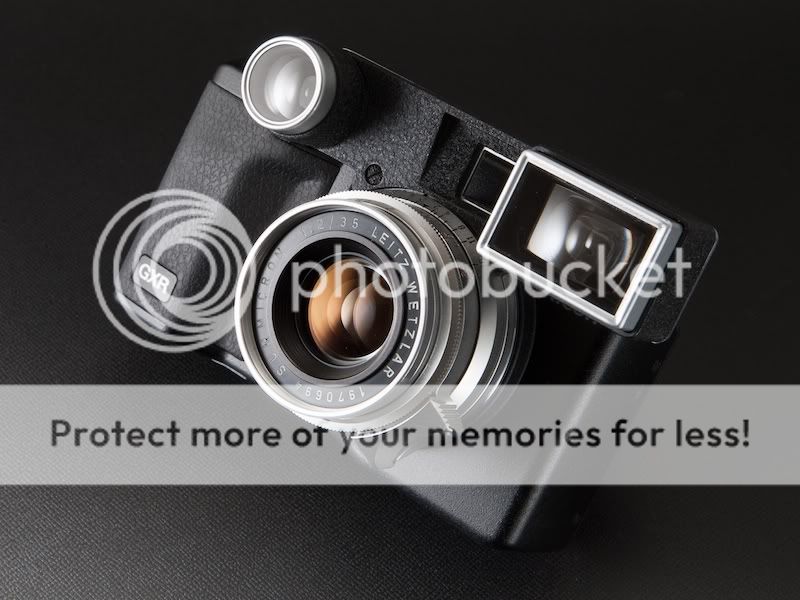Re: Not a "universal" M mount?
odklizec":wyrgylug said:
Tom Caldwell":wyrgylug said:
I am sititng there with a Jupiter 12 ready to use and just have acquired a Russar. I also have a GR28 #02613 ready to roar. I took a chance looking at the roomy interior of the prototypes.
GR28? Cool! I'm sure I saw a photo of the M mount with GR28 attached? So this one should definitely work. Current post at Ricoh GRblog shows M mount with attached GR21:
http://www.grblog.jp/2011/08/gxr-mount- ... ewdays.php
Tom Caldwell":wyrgylug said:
I have delayed getting LTM - M mount adapters as most on the market have been coded for Leica mount brightlines and I was unsure how Ricoh might deal with this. If I am right then there is no coding required and one simple LTM to M mount adapter will do the trick.
Oh yes, I hoped there will be implemented Leica coding system. But as long as there is an option to save the lens info into settings and save/recall these settings from memory/file, I don't really care about coding.
Tom Caldwell":wyrgylug said:
Still not sure about the Jupiter-12 as it has a 20mm rear protrusion. It has a great reputation and I would really hope that the M mount will handle it. Obviously one would understand that the GR28 should fit!
I believe there was, and probably still is a problem with mounting the M lenses on NX? I would not judge the possibility/impossibility to attach the M/L lens to M based camera because of negative NX experience. As far as I know, the NX is probably the worst system for usage with the M lenses? From what I found, Jupiter-12 works with M8/9 and so I guess it will work with A12 M mount as well? Read the discussion under this post:
http://www.stevehuffphoto.com/2011/01/0 ... -chisholm/
It seems it's older Jupiter-12 (made before 1971) what causes the problems?
Read the link, thanks. He is talking about the Jupiter-3 f1.5 and the Jupiter-8 f2.0 both 50mm Sonnar designs and very nice lenses to use. Of the two the J-8 feels slightly sweeter in use but the J-3 can produce knockout bokeh as he noted.
His prices seem a bit on the low side, so perhaps he was closer to the lottery, or prices are already on the move. For US$100 it you might still be able to buy a new (Russian speak) black J-8 and you might get a reasonably good black J-3 for $200. Black finish is generally better as it seems more durable. But black finish J-3's are rare and bordering on collector's pieces and might shortly start to take on closer to Leica prices.
These lenses because they are Sonnar design have little back protrusion. Not only this but I have been using both for a while on my NX. Great little lenses. Peculiarly the aperture ring rotates as the focus is changed (in synchronisation) ok once you get used to the notion. But you might have to lend a finger to hold focus when changing aperture - remember infinite aperture settings (no clicks).
The Jupiter-12 is something else - a Biogon design and so beautiful everyone should have one on their desk as a paperweight. It's rear protrusion is about 20mm. Looking inside my NX there is plenty of depth to fit one but the interior shape of the mount is "all wrong" - light baffles and a ledge to hold the electrical contacts quickly put paid to any notions of fit.
Reading postings on the credentials of the Jupiter-12 it seems to be regarded as "the best" of Russian rangefinder type lenses. It is 35mm f2.8 and as far as I know was made for a very long period without changes so that the first lenses assembled from actual Zeiss factory WWII parts are much the same as the last ones made probably 50 years later.
Again the silver ones seem to show wear and tear more easily. However well worn exteriors do not mean that the optics are no good. However after 30-50 years the original grease has perhaps turned to treacle from too many Russian winters. The contrast between a nice Leica lens and a nice Russian one is that for the price of a Leica one might expect it to be reliably overhauled by a competent tradesman. The Russian lenses are more like still in ex-factory condition less bumps and scratches and so-many cold winters, or worse, fixed up by Boris on the kitchen table with his mechanic's toolkit. However at the price I am happy with the value despite a few mistakes on the way.
Not that dealing with those in Russia or the Ukriaine is fraught. I have met my share of fleamarket stall owners but even these are honest with in their adopted trade. There are also some very reputable folk to deal with and their products are invariably as described and not over-enthusiastically so and good to deal with. Honest brokers do exist the world over folks are folks. Nevertheless as with any second hand purchase some prudent caution is necessary.
Shimming for focus is less of a problem on digital as there is no cam to worry about and the focus confirms visually anyway. More like the problem is that when Boris re-lubricated the helix he misaligned it putting it back together and the focus just ain't right at all. Screws get broken and the focus index ring might not be properly aligned.
So tales of woe about "Russian lenses" in my opinion are more to do with amateur repairs than the original quality control.




